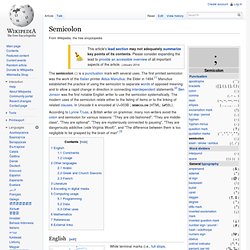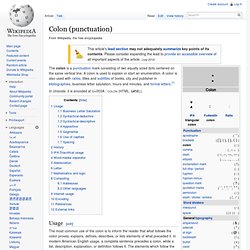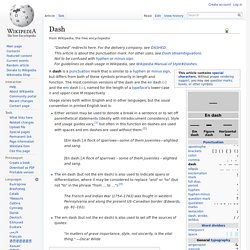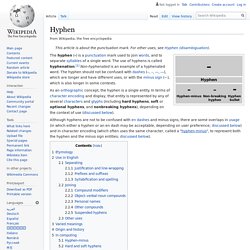

Semicolon. The semicolon (;) is a punctuation mark with several uses.

The first printed semicolon was the work of the Italian printer Aldus Manutius, the Elder in 1494.[1] Manutius established the practice of using the semicolon to separate words of opposed meaning and to allow a rapid change in direction in connecting interdependent statements.[2] Ben Jonson was the first notable English writer to use the semicolon systematically. The modern uses of the semicolon relate either to the listing of items or to the linking of related clauses. In Unicode it is encoded at U+003B ; semicolon (HTML: ;).
Colon (punctuation) In Unicode, it is encoded at U+003A : colon (HTML: :).

The most common use of the colon is to inform the reader that what follows the colon proves, explains, defines, describes, or lists elements of what preceded it. In modern American English usage, a complete sentence precedes a colon, while a list, description, explanation, or definition follows it. The elements which follow the colon may or may not be a complete sentence: since the colon is preceded by a sentence, it is a complete sentence whether what follows the colon is another sentence or not. Some writers prefer to capitalize the first letter after the colon; others do not. Both are correct in American English usage. colon used before list Williams was so hungry he ate everything in the house: chips, cold pizza, pretzels and dip, hot dogs, peanut butter and candy. colon used before a description Jane is so desperate that she'll date anyone, even Tom: he's uglier than a squashed toad on the highway, and that's on his good days.
Dash. "Dashed" redirects here.

For the delivery company, see DASHED. Usage varies both within English and in other languages, but the usual convention in printed English text is: Either version may be used to denote a break in a sentence or to set off parenthetical statements (ideally with intradocument consistency). Style and usage guides vary,[1] but often in this function en dashes are used with spaces and em dashes are used without them:[2][Em dash:] A flock of sparrows—some of them juveniles—alighted and sang. Common dashes[edit] There are several forms of dash, of which the most common are: Less common are the two-em dash (⸺) and three-em dash (⸻), both added to Unicode with version 6.1 as U+2E3A and U+2E3B. Figure dash[edit] The figure dash (‒) is so named because it is the same width as a digit, at least in fonts with digits of equal width. The figure dash is used when a dash must be used within numbers (e.g. phone number 555‒0199).
Comma. The comma is used in many contexts and languages, mainly for separating things.

According to the Oxford English Dictionary, the word comma comes directly from the Greek komma (κόμμα), which means something cut off or a short clause. A comma can also be used as a diacritic when combined with other characters. Comma variants[edit] The basic comma is defined in Unicode as U+002C , comma (HTML: ,) but many variants by typography or language are also defined.
History[edit] Uses in English[edit] In general, the comma is used where ambiguity might otherwise arise, to indicate an interpretation of the text such that the words immediately before and after the comma are less closely or exclusively linked in the associated grammatical structure than they might be otherwise. In lists[edit] Commas are used to join items in lists, as in They own a cat, a dog, two rabbits, and six mice.
Hyphen. Punctuation mark used to join words Although hyphens are not to be confused with en dashes and minus signs, there are some overlaps in usage (in which either a hyphen or an en dash may be acceptable, depending on user preference; discussed below) and in character encoding (which often uses the same character, called a "hyphen-minus", to represent both the hyphen and the minus sign entities; discussed below).

Etymology[edit] The word is derived from Ancient Greek ὑφ᾽ ἕν (hyph' hén), contracted from ὑπό ἕν (hypó hén), "in one" (literally "under one").[2][3] The word (ἡ) ὑφέν ((he) hyphén) was used for a tie-like (‿) sign written below two consecutive letters to indicate that they belong to the same word when it was necessary to avoid ambiguity, before the space was in regular use. Use in English[edit] The use of the hyphen in English compound nouns and verbs has, in general, been steadily declining. Separating[edit] Justification and line-wrapping[edit] Prefixes and suffixes[edit]